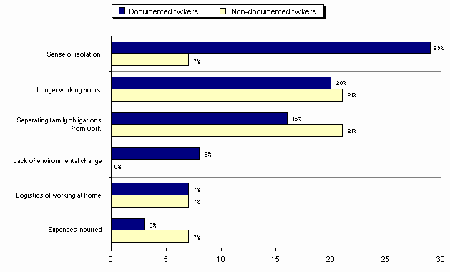Common menu bar links
Breadcrumb Trail
ARCHIVED - Number 9: Evaluation of Telework Pilot Policy - Findings
 This page has been archived.
This page has been archived.
Archived Content
Information identified as archived on the Web is for reference, research or recordkeeping purposes. It has not been altered or updated after the date of archiving. Web pages that are archived on the Web are not subject to the Government of Canada Web Standards. As per the Communications Policy of the Government of Canada, you can request alternate formats on the "Contact Us" page.
3. Impacts of Telework
3.1 Impacts on Personal and Professional Life
3.1.1 Teleworkers' Perspective
We asked teleworkers about the impact that their telework arrangement has had on a number of areas of their personal and professional life. For many of the items, respondents indicated that telework has resulted in a much better situation than was the case before they started to telework. A very large number of respondents reported positive change in the following areas: control over their work environment, job satisfaction, overall stress level, and flexibility to co-ordinate their work schedule with personal responsibilities. Respondents also noted a minor deterioration in certain areas.
Figure 7 shows the results for the areas with the greatest positive or negative change. The degree of change, as identified by documented and non-documented teleworkers, is reflected by the average ratings indicated in the figure. The respondents used a scale of one to seven to evaluate the degree of change, with 1 indicating much better than before, 4 no change and 7 much worse than before.
Figure 7
Rating of Change in Factors
Related to Personal and Professional Life
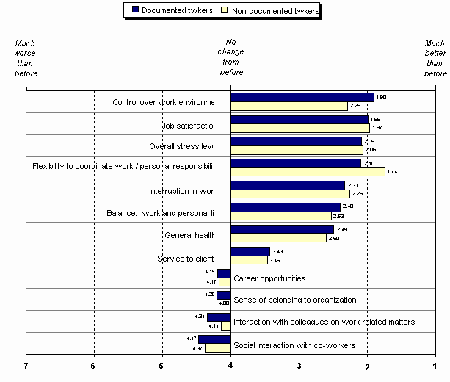
Teleworkers reported very little or no change in the other factors they were asked to consider. A review of the data by sub-groups of documented teleworkers reveals interesting differences in their perceptions of the professional and personal impact of telework. The main findings are as follows:
- The degree of improvement indicated in control over work environment, overall stress level, balance between work and personal life and general health is higher for women than for men.
- Persons with disabilities are more likely to report improvement in general health than the other respondents.
- Employees with a regular telework schedule report more improvement in their overall stress level, control over work environment, general health and job satisfaction than those with a flexible or ad hoc schedule.
- Respondents teleworking three days/week or more report more improvement than those working fewer days/week in terms of control over their work environment and job satisfaction.
- The level of deterioration in social interaction with co-workers, as reported by respondents, increases in relation to the number of telework hours.
- The higher the respondents' level of education, the smaller is the improvement reported in control over their work environment, overall stress level and general health.
- The higher the respondents' level of education, the larger is the deterioration reported in interaction with colleagues on work-related matters and social interaction with co-workers.
3.1.2 Supervisors' Perspective
Supervisors often differ in their assessment of the impact of telework on the professional life of teleworkers. When asked about a specific factor, some report improvement since the start of the teleworking arrangement while others report a deterioration, although the majority find no change. The majority of supervisors perceive "employee motivation at work" factor as the factor showing the most improvement. Figure 8 shows the distribution of the supervisors' ratings of the selected factors.
Figure 8
Changes Observed by Supervisors
in Factors Related to Professional Life

The supervisors' average ratings of the factors points out a marked improvement in employee motivation at work (average rating of 2.93)1 , a slight deterioration in attendance at important work-related meetings (average of 4.08), as well as some deterioration in the co-ordination of work between teleworkers and their colleagues (average of 4.20).
3.1.3 Comparison with the Control Group
As already mentioned, we used the control group to test the hypothesis that telework improves various aspects of teleworkers' professional and personal lives.
Respondents in the control group reported little change over the last year in the same factors related to professional and personal life. Their average rating of the changes fell between 3.5 (slight improvement) and 4.5 (slight deterioration).
As shown in Figure 9, the factors in which the control group indicated some improvement are, in order, their ability to give direction/feedback to staff supervised, interaction with colleagues on work-related matters, flexibility to co-ordinate work/personal responsibilities and service to clients. However, the improvement reported by the control group is far less pronounced than that reported by the teleworkers. For the control group, the factor that has deteriorated the most is their overall stress level.
Figure 9
Comparison between Teleworkers and Control Group on Change in
Factors Related to Personal and Professional Life

When asked how frequently their professional life encroached on their personal life or vice versa, most control group respondents answered "infrequently". Moreover, they indicated that their employer helps them achieve a better balance between their professional and personal life by permitting flexible work schedules, leave for family reasons, alternative work arrangements, etc., which could explain the improvement they reported in their flexibility to co-ordinate work and personal responsibilities.
The area in which they indicated the most deterioration is stress. The majority of these respondents reported experiencing work-related stress, but very little stress related to commuting or to the impact of family responsibilities on their work.
It should be noted that the main factors in which teleworkers indicated great improvement since the introduction of telework are the very factors in which the control group respondents reported slight deterioration over the last year.
3.2 Impacts on Teleworkers' Productivity
3.2.1 Teleworkers' Perspective
We asked respondents to evaluate the impact that teleworking has had on the following elements of productivity: volume/quantity of work produced, quality of work produced, the ability to meet deadlines, absenteeism, punctuality, and the ability to complete work without needing overtime. Many teleworkers claimed notable improvements in their overall productivity and in the component elements. Figure 10 shows the degree of improvement in these elements among documented teleworkers, as evaluated by themselves and by their supervisors, as well as the degree of improvement reported by non-documented teleworkers. For this rating, respondents used a scale where 1 indicates much better than before (teleworking), 4 indicates no change from before, and 7 indicates much worse than before.
Figure 10
Average Rating of Change in Teleworkers' Productivity

Statistical analysis of the survey response patterns of documented teleworkers with regard to these work impact questions shows the following:
- The improvement noted in volume/quantity of work produced, in overall productivity and in absenteeism is more pronounced for those teleworking on a regular schedule and for those who telework for 3 or 4 days a week.
- Women report to a greater extent than men that telework has led to improvement in the quantity of work produced, overall productivity and absenteeism.
- Persons with disabilities report greater improvement in illness-related absenteeism than do the other respondents.
- Teleworkers who report a decrease in their overtime hours also consider themselves more productive.
- The higher the respondent's level of education, the smaller is the improvement in terms of work volume, meeting deadlines and illness-related absenteeism.
As shown in Figure 10, non-documented teleworkers also indicated a marked improvement in their overall productivity and in the volume and quality of the work they produced. The results are similar to those of documented teleworkers, although the order and degree of improvement in these various elements differ slightly.
Anecdotal information from the focus groups support these survey findings. Several supervisors mentioned productivity increases among their teleworking employees, for example, that the employee's work is handed in earlier than before, that the work is of better quality and gets done faster, that the employee has the same deadlines but is able to take on more work.
For their part, teleworkers participating in focus groups commented that telework allows them to be more productive:
- every working hour is productive on telework days, as opposed to maybe only five productive hours for a day in the official workplace
- they can rest when needed and then return refreshed to the task
- their work is of better quality
- they can meet shorter deadlines or handle a larger volume of work.
We obtained several concrete examples, although these are not necessarily reflective of teleworkers' productivity increase in general:
- one participant employed as an investigator reported that, since telework was introduced in his work unit, the average time to render an investigation decision has fallen from 18 to 3 months. On his telework days, he can produce twice as many decisions as on a day working in the office.
- a participant who is a writer/editor reported being able to do better quality work in much less time. She arranged with her supervisor to cut her work deadlines by half.
- other participants also indicated: "We have increased our productivity – we have almost doubled our production some months".
3.2.2 Supervisors' Perspective
The supervisors did not rate productivity gains of their teleworkers as positively as did the teleworkers themselves. However, supervisors also believe that the work efforts of employees have improved since the introduction of teleworking – absenteeism, the quantity and quality of work, and employees' ability to meet deadlines are all reported to be better under telework, as shown in Figure 10.
3.2.3 Comparison with the Control Group
The control group respondents reported little change in the elements of productivity, except for slight improvements in overall productivity and in quality of work, and a slight deterioration in illness-related absenteeism (see Figure 11).
Figure 11
Average Rating of Change in Productivity
by Control Group and Documented Teleworkers

3.3 Impacts on the Work Unit
Since any gains on the part of teleworkers should not come at the expense of co-workers, this section deals with impacts on the productivity and professional life of other members of the work unit.
3.3.1 Supervisors' Perspective
The supervisors indicated whether their situation with regard to certain factors had improved, deteriorated or stayed the same since one or more of their employees had begun teleworking. They generally feel that telework has not influenced greatly their ability to carry out certain managerial aspects of their job. Although their ability to communicate instructions and feedback to teleworkers has worsened somewhat, their overall productivity has improved. Figure 12 shows the distribution of supervisors' opinions regarding these factors.
Figure 12
Change in Factors Related to
Managerial Duties and Productivity of Supervisors
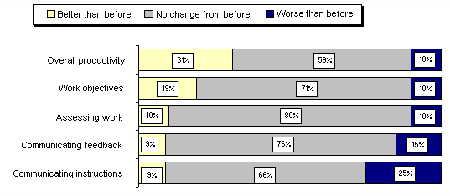
We find it very surprising that the great majority of supervisors reported no changes in the way they assess the work performed by teleworkers, communicate feedback or instructions to them, and set work objectives. As a matter of fact, during the teleworker focus groups, some participants expressed displeasure over their supervisors' still placing far too much emphasis on monitoring or on the employee's physical presence in the workplace and not enough on results.
In terms of work-related changes made in order to accommodate teleworking employees, the most common ones cited by supervisors involved scheduling of meetings, distribution of work, and improvements in communications.
3.3.2 Dependent Colleagues' Perspective
In interpreting the results of this section, we must remember that only 29% of the dependent colleagues consider their work to be at least moderately interdependent with that of the teleworker. Also, as shown in later sections, some co-workers may resent their colleague's telework arrangement, a factor which may colour their perception of the impacts of telework on their work and work unit.
The majority of dependent colleagues reported little change, other than with regard to stress, in the various factors assessing the impact on their professional life of working with a teleworker. 26% of them reported deterioration which increases in proportion to the colleague's degree of dependence on the teleworker (see Figure 13).
Figure 13
Impacts of Working with a Teleworker on
Professional Life of Dependent Colleagues

Regarding work-related issues, colleagues reported the effect of the telework arrangement to be relatively minimal. However, when the respondents did report changes, these changes are more often negative than positive, as shown in Figure 14.
The factors with the most deterioration are the following: being asked to do urgent jobs, teamwork, service to clients and the ability to meet deadlines. As for improvements, respondents also cited teamwork. They noted a smaller level of improvement in the variety of tasks and the challenge of assigned work.
Figure 14
Impacts of Working with a Teleworker
on Work of Dependent Colleagues

Note: Percentage may not add to 100% due to rounding.
The most difficult adjustments that the dependent colleagues had to make since working with a teleworker primarily involve scheduling meetings, communication problems and increased workload.
A review of the data by subgroups indicates that:
- men are more likely than women to report that the frequency of being asked to do urgent jobs and that teamwork had worsened under the telework arrangement.
As for their part, supervisors noted only a marginal impact of telework on the dependent colleagues – a very slight deterioration in work co-ordination and a very slight improvement in productivity.
3.4 Other Impacts on the Organization
It is also fitting to look at the savings that could result from telework which might counterbalance the initial startup costs and permit departments to recover these costs over a reasonable period. This section addresses these issues.
3.4.1 Costs
We asked supervisors about the costs incurred in order to accommodate employees who want to telework. The results in the table below show the percentage of supervisors' responses.
|
Source |
Nil |
< $200 |
$200- |
$1000- |
$3000-4999 |
> $4999 |
Don't know |
|---|---|---|---|---|---|---|---|
|
Ave. cost/twker for electronic equipment |
32% |
15% |
18% |
11% |
6% |
3% |
15% |
|
Other costs |
54% |
17% |
9% |
1% |
1% |
-- |
18% |
Two thirds of respondents reported relatively low equipment costs – under $1000. The majority had not incurred any additional costs for such items as training, furniture, installing a business phone line, pagers, etc. Almost all supervisors (92%) felt that they have either recouped the costs or will be able to do so, primarily through an increase in productivity, reduced absenteeism, or savings on office space.
3.4.2 Implications for Office Space
To date, most organizations do not seem to have taken advantage of the potential savings on office space that results from having employees telework. 74% of the documented teleworkers still have personal space at the official workplace, and this same proportion of respondents would be willing to share space (e. g. share a workstation) if it became a condition of teleworking. The figures for the non-documented group are 97% and 54%, respectively. In a similar vein, if current teleworkers decided to end their arrangement and return to the office full-time, this would not be a problem for most supervisors – only 10% replied that they would not have space available for the employee.
A further breakdown of the responses indicates that:
- employees teleworking more than two days a week are more amenable to sharing their work space at the office than are those teleworking two days or less.
- men are more likely to indicate that they do not have a personal office space at the office.
The question of savings on office space requires more study.
3.5 Impacts on Teleworkers' Personal Expenses
Except for transportation, the majority of documented teleworkers experienced no change in their monthly expenses as a result of their work arrangement, as shown in the following table. When they did report a change, it was generally decreased expenses. The non-documented group reported the same experience.
|
|
Decrease |
|
Increase |
|||||
|---|---|---|---|---|---|---|---|---|
|
Type of expense |
% of N |
$ (avg.) |
No change |
% of N |
$ (avg.) |
|||
|
Transportation* |
64% |
$60 |
32% |
2% |
$61 |
|||
|
Food |
39% |
$46 |
58% |
3% |
$47 |
|||
|
Clothing |
34% |
$48 |
66% |
0% |
-- |
|||
|
Childcare* |
8% |
$141 |
62% |
0% |
-- |
|||
|
Utilities |
1% |
$19 |
53% |
46% |
$27 |
|||
|
Home Insurance* |
1% |
$24 |
93% |
4% |
$12 |
|||
We noted that some of the average expense figures contain large fluctuations. For example, the monthly decrease in childcare expenses averages $141 but ranges from $20 to $400, and the decrease in transportation expenses ranges from $1 to $500 for an average of $60.
The changes in expenses reported by many teleworkers may add to the positive perception they hold of this type of work arrangement. A review of the subgroup data reveals some interesting facts:
- respondents teleworking a greater number of hours are more likely to indicate a decrease in food, clothing and transportation expenses, as well as an increase in their utility expenses
- women are more likely to indicate that food and clothing expenses have decreased as a result of telework
- men are more likely to report that transportation costs have been lower since teleworking
- women are more likely to report that child care costs have decreased since teleworking
- findings are fairly consistent across age groups, although the 35-44 age group is more likely than their counterparts to indicate that child care expenses have decreased.
3.6 Impacts on Child and Family Care Responsibilities
In this study, we sought to determine if employees choose to telework in order to accommodate their responsibility for providing care to family members. We also wanted to see if providing such care has any impact on the teleworker's professional responsibilities.
The table below identifies how many of the documented teleworkers indicated they have children at home, how many of those workers have children that require care, and how many have one or more adults in the home who need care. Comparative figures are shown for the control group. The TOTAL reflects the fact that some of the respondents either have children needing care in both age categories, or have at least one child and one adult at home who need care. Therefore, the 32 teleworkers in this situation actually account for at least 38 individuals who need care.
|
|
Documented |
Control Group |
||
|---|---|---|---|---|
|
|
# |
% |
# |
% |
|
Respondents with children 5 years or younger |
128 |
23% |
34 |
23% |
|
16 |
13% |
1 |
3% |
|
Respondents with children over 5 years old |
220 |
40% |
74 |
49% |
|
8 |
4% |
7 |
10% |
|
Respondents with adult at home needing special care |
14 |
3% |
7 |
5% |
|
Total respondents with at least one person needing care |
32 |
6% |
15 |
10% |
It is interesting to note that proportionally more employees in the control group (10%) than in the teleworker group (6%) have persons in their home who need care. It does not appear that the need to provide care to family members is what motivates employees to telework. This finding is consistent with the replies on the survey question regarding reasons to telework – only one individual mentioned "don't need baby-sitter" as their motive.
Most respondents indicated they were not responsible for providing care to any of these family members during their telework hours. Of those who are responsible for providing care during work hours, only a handful replied that it interfered, or partly interfered, with their work. When there was interference reported, it was mainly in the "partly" category and mostly involved children.
4. Respondents' Evaluation of Telework
4.1 Perceived Benefits of Telework
When evaluating a program such as this, it is important to know what the various stakeholders perceive to be its benefits. In this section, we present the opinions expressed by the following groups:
- documented, non-documented and former teleworkers
- supervisors of teleworkers
- dependent colleagues of teleworkers
- departmental telework co-ordinators.
4.1.1 Teleworkers' Personal Life
In our surveys, we asked documented and non-documented teleworkers to list what they perceive to be the principal benefits of telework in their personal life. We asked the former teleworkers the same question in our phone interviews. Figure 15 below shows the overall frequencies of the principal benefits cited (multiple answers were accepted).
Figure 15
Perceived Benefits in Teleworkers' Personal Life
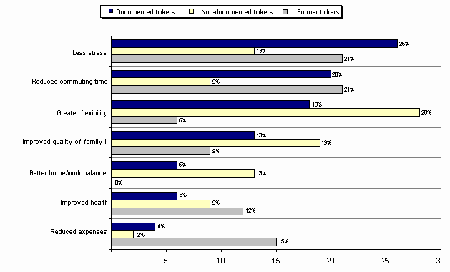
Although both documented and non-documented teleworkers cited the same six principal benefits, they accorded them different importance. For the documented group, "less stress" was the most frequently cited benefit, whereas "flexible hours – can help deal with personal life/emergencies" was the most frequently cited by the non-documented group. This difference may in part reflect the differences in telework patterns of the two groups, as discussed previously. (The documented group is likelier than the non-documented to adopt a regular telework schedule and more telework hours/week on average.)
Our analysis showed that:
- "less stress" and "reduced commuting time" were the two most frequently-cited benefits by documented teleworkers in all age groups
- for the 33 documented teleworkers who consider themselves disabled, "less stress" and "improved health" share top billing as the two main benefits of telework.
Although none of the 14 former teleworkers mentioned "better home/work balance" in response to this question, on a later summary question, 12 of them replied that telework helped them achieve a better balance between their personal and professional life.
4.1.2 Teleworkers' Professional Life
We asked documented, non-documented and former teleworkers to identify benefits in their professional life. Figure 16 below shows the overall frequencies of the principal benefits cited (multiple answers were accepted).
Figure 16
Perceived Benefits in Teleworkers' Professional Life
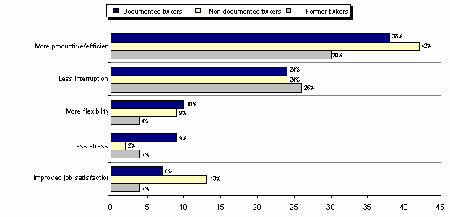
"More productive/efficient" and "less interruption" were the main professional benefits cited by documented teleworkers in all age groups, regardless of disability status, and by non-documented and former teleworkers.
4.1.3 Supervisor's Perceptions of Advantages
We asked supervisors what they believe are the main advantages of telework from an organizational perspective. Figure 17 below shows the overall frequencies of their responses (multiple answers were accepted).
Figure 17
Advantages for the Organization according to Supervisors

The most frequently-cited response, "more productive/efficient", was what teleworkers cited as the most important professional benefit of telework. In other words, what teleworkers feel is professionally satisfying for themselves is also seen by supervisors as advantageous for the organization. The next most important advantages according to the supervisors, "better morale" and "better quality of work", contribute as well to an overall improvement in employee productivity. Two of the remaining advantages, "less interruption" and "more flexibility" parallel advantages cited by teleworkers for their professional life.
Supervisors elaborated on similar advantages in the focus group discussion – improvements in efficiency, productivity, employee morale, and client service. Another advantage they identified is that telework can increase the organizational skill of supervisors by forcing them to plan better.
4.1.4 Dependent Colleagues' Perceptions of Advantages
The survey asked dependent colleagues what they believe are the main advantages of working with a teleworker. The table below shows the overall frequencies of their responses (multiple answers were accepted).
|
Response |
Total Frequency |
|---|---|
|
Better morale/happier workers |
20% |
|
Less interruption |
19% |
|
Less stress |
15% |
|
More productivity/efficiency/deadlines met earlier |
15% |
Since it is unclear if these colleagues were citing advantages for themselves of working with a teleworker, we repeated the question in the five phone interviews of colleagues that substituted for a focus group. While one of the five colleagues experienced no personal advantages, the other four identified the following:
- the teleworker's productivity can increase the production rate for the whole unit
- having a happier colleague due to telework creates a better office environment for all
- by becoming more efficient and independent, the teleworker calls on the colleague less often, resulting in better rapport and use of time for both
- a boss who teleworks becomes more flexible and likelier to respond positively to a subordinate's request for other types of alternative work arrangements.
4.1.5 Departmental Co-ordinators' Perceptions of Advantages
Departmental telework co-ordinators cited many of the same advantages for employees and for the organization already mentioned by other stakeholders. Among them are the following:
- better balance for the employee between work and personal responsibilities
- increased productivity
- improved employee morale
- real or potential savings for the employer (especially important during periods of restraint)
- increased flexibility for both employees and the employer.
4.2 Perceived Disadvantages of Telework
Just as there are benefits in teleworking, there are also problems or disadvantages which can affect teleworkers, their supervisors and colleagues. In this section, we present the views of these stakeholders.
4.2.1 Teleworkers' Personal Life
We asked documented and non-documented teleworkers to list what they perceive to be the principal problems of telework in their personal life. Figure 18 shows the overall frequencies of the principal personal disadvantages cited (multiple answers were accepted).
Figure 18
Perceived Problems in Teleworkers' Personal Life
Both groups generally identified similar problems but with different levels of importance. For documented teleworkers, the "sense of isolation" (29% of citations) was the most important, while "longer working hours" and "separating family obligations from work" were the most cited by the non-documented group (each garnering 21% of citations). The former group's choice of "isolation" as the most significant personal problem may reflect the fact that on average they telework more hours/week than does the latter group.
The 14 former teleworkers interviewed by phone most frequently cited the following personal problems: logistics of working at home and sense of isolation.
4.2.2 Teleworkers' Professional Life
The survey also asked respondents to identify any problems of telework in their professional life. Figure 19 shows the results, in terms of the frequency with which each problem was cited (multiple answers were accepted).
Figure 19
Perceived Problems in Teleworkers' Professional Life

Both groups agreed on the two main problems – lack of resources/equipment and isolation from co-workers. The group of former teleworkers also identified these as the main professional problems. Lack of resources/equipment covers a number of related themes such as limited access to files, data and clerical support, as well as specific equipment problems, including having less powerful computers, no access to mainframe data banks, etc.
"Isolation" shows up as both a personal and professional problem of telework, making it by far the most important. Respondents may be unsure if this disadvantage is mainly personal or professional, perhaps referring to the personal aspect in the sense of "loneliness", and the professional in the sense of "not in the office communications loop". A further breakdown of survey data showed that among those documented teleworkers who felt isolated, more than half did not use either a business phone line or e-mail.
4.2.3 Supervisors' Perceptions of Disadvantages
We asked supervisors to identify any disadvantages to the organization of having employees telework. Figure 20 below shows the overall frequencies of their responses (multiple answers were accepted).
Figure 20
Disadvantages for the Organization according to Supervisors
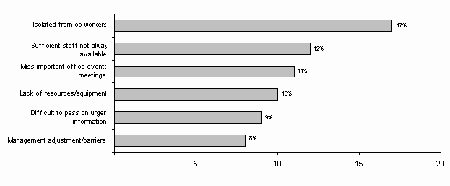
A number of these relate to the physical absence of teleworkers from the official workplace, highlighting supervisors' concerns that their teleworking employees may be missing important information and events that can contribute to teamwork and organizational culture.
4.2.4 Dependent Colleagues' Perceptions of Disadvantages
We asked dependent colleagues what they perceived to be the disadvantages (if any) of working with a teleworker. Figure 21 profiles their responses (multiple answers were accepted).
Figure 21
Disadvantages according to Colleagues
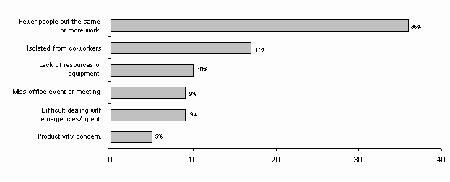
Colleagues can be overlooked or feel left out when telework is implemented in a work unit. They often perceive that their workload increases because they are assigned minor or urgent tasks which would previously have been distributed among everyone in the work unit, but which are now distributed only among those present in the official workplace. Some of the respondents saw this as beneficial to them in terms of job enrichment; most did not welcome the chores.
From a different perspective, dependent colleagues reported that the most difficult adjustments they had to make since starting to work with a teleworker were the following (in order of frequency with which the adjustment was cited):
|
|
scheduling meetings |
27% |
|
|
communications problems with the teleworker |
21% |
|
|
increased workload |
19% |
|
|
remembering the teleworker's schedule |
6% |
4.2.5 Departmental Co-ordinators' Perceptions of Disadvantages
Telework co-ordinators also perceived some disadvantages or problems, for the teleworkers and for their organization, which can be grouped as follows:
Equipment-related:
- lack of access to mainframe computers
- security concerns regarding the confidentiality of client data
- problems providing technical support when computers break down in the teleworkplace
- a possible lack of ergonomic furniture in the teleworkplace
Management-related:
- management's conservative attitude and lack of appreciation of telework's potential advantages
- the initial costs and potential longer-term costs of implementing telework
- the adjustment period needed to adapt to telework
Personal disadvantages for the teleworker:
- the lack of flexibility inherent to the TBS Policy
- the possible effect on teleworkers' careers in a time of workforce reduction
- complaints or resentment of colleagues
- isolation from co-workers.
4.2.6 Problems Perceived by the Focus Groups
We held focus groups of documented (three groups) and non-documented teleworkers (two groups), and supervisors (one group) in order to increase our understanding of some of the problems cited in the surveys and gather suggestions for improvements to the telework policy and practices. Presented below is a compilation by theme of the participants' comments on problems. The suggestions and solutions they discussed are presented in Section 5.2.
|
Equipment: Unsatisfactory access and/or equipment hinders inter-colleague communications and productivity. |
- Equipment is unavailable, inefficient or may be incompatible (when available).
- Some teleworkers had to equip themselves.
- There is a problem with obtaining technical support at home.
- There was no "official" access to the main database because of security problems.
|
Attitude: The attitude of management will make or break telework. |
- There is a lack of trust between management and employees.
- Expectations of management can be either too high or not clearly established in the beginning.
- There can be too much focus on quantity (productivity) and not on quality in assessing teleworkers' performance.
- Telework is difficult for managers who manage by presence and not by results.
- There is a reluctance to allow telework or, when it is permitted, to consider teleworkers at home as really working.
- Senior management does not set the example by teleworking themselves.
- It is left to managers' discretion to approve telework which is seen as being too subjective.
|
Information: Knowledge is not being disseminated. |
- The management of, and the conditions governing telework vary greatly from one department to another, and even within sections of the same department.
- All stakeholders have not received sufficient training prior to the start of telework in their unit.
- Problems experienced by teleworkers and/or by their managers must be solved in isolation, as resource people have not been identified or their identity not circulated to those concerned.
- Employees and supervisors are left on their own to make telework succeed as little infrastructure exists to help them in their department.
|
Personal: Theexpectations of themselves and others, and disruptions by others can cause responsibility overload. |
- It can be difficult to balance the priorities of work responsibilities and home responsibilities while teleworking.
- Some teleworkers need to constantly justify their working at home to their family and friends.
- Some experience guilt feelings if they are not working every single minute or if they are not "reachable" by colleagues at all times.
- The core hours of work, set out in collective agreements and retained by the telework policy, do not give adequate flexibility to those who like to work at another time.
- Loneliness or isolation is a concern.
|
Systemic: Some problems are inherent to telework. |
- Trying to combine flexible hours and/or alternative work arrangements (such as a compressed work week) with telework can cause problems.
- Managers can find it difficult to explain to some employees that they do not trust them at home or that they are not the type of employee that could telework.
- Telework can affect inter-personal relationships in the work unit, causing frustration, resentment, and jealousy, among those who cannot, or choose not to, telework.
4.3 Level of Satisfaction with Telework
Our survey asked documented and non-documented teleworkers how satisfied they are with telework. Both groups indicated high levels of satisfaction, as shown in Figure 22. Respondents rated their degree of satisfaction on a 7-point scale where 1 is extremely satisfied, 4 is neutral, and 7, extremely dissatisfied.
Figure 22
Teleworkers' Ratings of Satisfaction (by Percentage of Respondents)
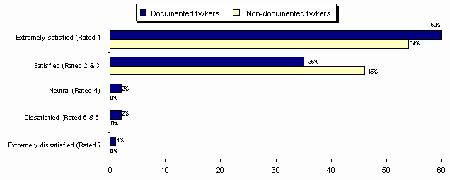
Further statistical analysis produced some interesting findings:
- university-educated teleworkers were slightly less satisfied with teleworking than were teleworkers with lower levels of formal education
- employees who had been teleworking for a longer period of time were slightly more satisfied with teleworking than those who had been involved for a shorter period of time
- there is a correlation between the teleworkers' satisfaction with telework and the support of their supervisor, as well as the supervisor's availability on telework days.
4.4 Levels of Stakeholder Support
To succeed, telework needs the support of those who are affected by its introduction in their midst. Our surveys gathered information on this element, as described below; the findings are in Figure 23.
- we asked both groups of teleworkers to indicate what they perceive to be their immediate supervisor's level of support for telework, using a 7-point scale, where 1 represents extremely supportive, 4 is neutral, and 7 represents not at all supportive
- we asked supervisors of documented teleworkers to indicate their own level of support for telework, using the same scale
- we asked the control group to indicate what they perceive to be their supervisor's level of support for telework, again using the same scale.
Figure 23
Supervisors' Support of Telework (as Perceived by Respondents)

Note: Percentage may not add to 100 due to rounding.
The vast majority of both groups of teleworkers felt that their supervisor was supportive, an opinion shared by the control group. Breaking down the documented teleworker data by sub-group, we noted some interesting points:
- university-educated teleworkers were slightly less likely to feel that their immediate supervisor is supportive
- teleworkers who perceive their supervisor as supportive were more likely to have reported that the supervisor is available to them on their telework days.
A high proportion of supervisors of documented teleworkers (77%) rated themselves as being supportive of telework. In contrast to their teleworkers, however, they were less likely to rate themselves as extremely supportive (29% vs. 45%).
Further analysis shows that the supervisors' support does not depend on their gender, category, educational level, geographic location, years of service or of supervisory experience, number of employees, whether they themselves telework, or the telework pattern of their employees. As noted in Sub-section 2.3.2, the more useful supervisors perceived the information that they had received on telework to be, the more supportive they were of telework in general.
To judge their level of support or acceptance of telework, we asked dependent colleagues if they felt that telework has had a positive impact on the morale of their work unit. 56% of them agreed that it has had a positive impact, 29% were neutral, and 15% did not agree that the impact was positive.
4.5 Telework as Perk or Privilege
There is a divergence of opinion regarding telework as an alternative work arrangement. Some view it as just another work arrangement, on a par with working a compressed week or part-time. Some consider it a perk or privilege, a kind of fringe benefit not available to the broad range of employees. Among the opinions we noted are the following:
- Almost three out of every four dependent colleagues we surveyed feel that it is a privilege. This may indicate envy on their part, or an uneasiness about the fairness and transparency of the approval process. It may, however, equally indicate that they see it as a benefit they could also obtain in the future, if they so choose.
- Teleworkers in the focus groups felt that some of their co-workers thought they (the teleworkers) had received a perk and were jealous.
- Public Service bargaining agents would like to see telework negotiated as part of the collective agreements. They are concerned that being allowed to telework often resembles more a private deal between management and the employee.
- In their focus group, supervisors strongly felt that approving telework should remain at the discretion of management.
4.6 Views of Bargaining Agents
We have already presented in Sub-sections 2.3.6 and 4.5 some of the views expressed by officials of the five bargaining agents we interviewed in the course of this evaluation. We found that the bargaining agents are generally supportive of telework. Nevertheless, they did express concern in the following areas:
- electronic equipment – who should pay for it and should employees be reimbursed for use of their own equipment
- security of data and equipment in the teleworkplace – the risk this can represent for employees
- managers' productivity expectations of teleworkers – are teleworkers required to produce more than similar employees working in the official workplace
- hours of work – the incidence of "time-shifting", "time-splitting" and doing voluntary unpaid overtime
- guidelines for ending a telework arrangement – ensuring that it is not terminated hastily, requiring rapid lifestyle adjustments for the employee, as well as that office space will be available for teleworkers who choose to stop teleworking
- communications with teleworking union members – the desire to receive a list of such employees from the employer
- the public's perception of teleworkers – will the general public view them as "paid but not working"
- the appropriateness of telework as an answer to accommodating the needs of disabled employees and those seeking a more affordable child care solution.
5. Conditions for Successful Telework
5.1 What Makes Telework Work?
In the focus groups and in discussions with the departmental telework co-ordinators, the evaluation sought opinions on the factors which contribute to a successful telework arrangement. There was general consensus on the following factors:
- the right employee selected to telework – someone who is independent, hard-working, organized and motivated
- a supervisor and senior management who are supportive of telework
- trust between the supervisor and employees
- managing by results, with a suitable method to evaluate employees' work performance
- the teleworker, the supervisor and all colleagues in the work unit sensitized to telework and its possible effects on themselves and their relationships
- rules of the game established up front between the supervisor and the teleworker, and between the teleworker and other members of the household
- a break-in period for the telework arrangement, monitored by the supervisor
- teleworking only part of the work week, not full-time
- a departmental or central agency policy to provide direction and consistency.
5.2 Suggestions for Improvement
In each of our surveys, interviews and focus groups, we sought participants' suggestions for improving telework in their organization. Ideas centered around correcting immediate problems (principally equipment-related) and facilitating telework, both within workgroups and within the Public Service over the long-term. Many of the participants made very similar suggestions, as shown in the following chart:
|
Suggestion |
|
|
|
|
|
|
|
||||||||
|---|---|---|---|---|---|---|---|---|---|---|---|---|---|---|---|
|
Provide better EDP & communications equipment |
X |
X |
X |
X |
|
|
X |
||||||||
|
Resolve access to LANs & central data banks |
X |
|
X |
X |
|
|
|
||||||||
|
Provide more support, training re: equipment |
|
|
|
X |
|
|
X |
||||||||
|
Promote telework, educate Public Service on its merits |
X |
X |
X |
X |
X |
X |
X |
||||||||
|
Allow more telework (extend eligibility to more employees and more hours; less elitist approval criteria) |
X |
X |
X |
X |
X |
X |
X |
||||||||
|
Limit telework (set maximum number per work unit, maximum hours per week) |
X |
|
X |
|
|
|
X |
||||||||
|
Train managers re: trust and managing by results |
X |
X |
X |
X |
X |
|
X |
||||||||
|
Provide incentives to Senior management (encourage them to include telework in business plan; encourage them to telework) |
X |
X |
|
|
X |
|
|
||||||||
|
Maintain policy for consistency |
|
X |
|
X |
X |
X |
|
||||||||
|
Include telework in collective agreements (to ensure consistency, fairness, recourse) |
X |
|
|
|
X |
X |
|
||||||||
|
Hold regular meetings of supervisor, teleworker, colleagues, to keep lines of communication open, resolve administrative problems |
|
|
X |
X |
|
|
X |
||||||||
|
Changes in office workspace to maximize functionality and savings |
|
|
X |
X |
|
|
|||||||||
Note: A bold X indicates strong endorsement of the suggestion by that respective group.
5.3 Policy Considerations
In the focus group discussions, we sought participants' views on the necessity and utility of maintaining the TBS policy on telework. A majority of participants felt that a policy, either departmental or that of TBS, is essential to making telework succeed. In departments which have not promulgated a separate policy, the central agency policy is seen as "a safety net like acrobats use". It constitutes official recognition of telework by the Employer, and while some perceive it as rigid, it at least permits telework to occur.
If TBS were to withdraw its policy, thereby allowing departments full latitude in the area of telework, the majority of participants felt that implementing telework might not be a priority of departments. As well, withdrawing the policy would be interpreted by many as a signal that the Employer no longer supports telework. Participants saw a need for central direction, consistency and uniformity, and for credibility, at least during the "kick-off" period.
Most departmental telework co-ordinators reported that the TBS policy has been generally adapted with little or no modification. The distribution of the policy, however, varied greatly between departments. In some, the policy was simply distributed with a covering letter, while in others, the distribution was accompanied by a complete information kit and information sessions or publicity in employee newsletters.
Appendix A – Methodology
|
Group |
Details on Sampling and Data Collection |
|---|---|
|
Documented teleworkers |
Survey
Focus Groups
|
|
Non-documented teleworkers |
Survey
Focus Group
|
|
Supervisors of documented teleworkers |
Survey
– 189 supervisors were mailed the questionnaire in March 1995 – the remaining 46 supervisors were surveyed by phone in March 1995
Focus Group
|
|
Dependent colleagues of teleworkers |
Survey
Focus Group
|
|
Control group |
Survey
|
|
Supervisors of non-documented teleworkers |
Interviews
|
|
Former teleworkers |
Interviews
|
|
Supervisors of former teleworkers |
Interviews
|
|
Employees denied telework |
Interviews
|
|
Departmental telework |
Survey
Interviews
|
|
Bargaining agents |
Interviews
|
Appendix B – Survey Questionnaires
Survey questionnaire to:
1. Documented Teleworkers
2. Non-Documented Teleworkers (identical to the above except for Section B included here)
3. Supervisors of Documented Teleworkers
4. Dependent Colleagues
Appendix C – Departmental Breakdown of Survey Respondents
|
Department |
Documented |
Non-doc. |
Control |
Dependent Colleagues |
|---|---|---|---|---|
|
Agriculture and Agri-Food |
10 |
1 |
4 |
8 |
|
Canadian Heritage |
3 |
3 |
2 |
2 |
|
CIDA |
2 |
1 |
-- |
-- |
|
Citizenship and Immigration |
2 |
class="alignCenter"
2 |
-- |
3 |
|
Environment Canada |
5 |
-- |
1 |
2 |
|
Federal Court of Canada |
1 |
-- |
-- |
-- |
|
Federal Office of Regional Development (Quebec) |
|
|
|
|
|
Finance |
3 |
-- |
2 |
1 |
|
Fisheries and Oceans |
1 |
-- |
1 |
1 |
|
Health Canada |
16 |
2 |
2 |
4 |
|
Human Resources Development Canada |
|
|
|
|
|
Immigration and Refugee Board |
7 |
-- |
3 |
1 |
|
Indian and Northern Affairs |
1 |
-- |
1 |
-- |
|
Industry Canada |
17 |
13 |
3 |
2 |
|
Justice |
6 |
1 |
2 |
2 |
|
National Defence |
3 |
-- |
2 |
1 |
|
National Library |
3 |
-- |
1 |
-- |
|
National Parole Board |
-- |
1 |
-- |
-- |
|
National Transportation Agency |
5 |
-- |
1 |
-- |
|
Natural Resources Canada |
6 |
-- |
1 |
1 |
|
Public Service Commission |
3 |
5 |
1 |
1 |
|
Public Works and Government Services |
|
|
|
|
|
Revenue Canada |
341 |
1 |
93 |
52 |
|
Solicitor General |
1 |
-- |
-- |
-- |
|
Statistics Canada |
38 |
-- |
8 |
5 |
|
Transport Canada |
21 |
-- |
4 |
5 |
|
Treasury Board Secretariat |
1 |
2 |
-- |
1 |
|
Veterans Affairs Portfolio |
22 |
-- |
10 |
2 |
|
Unidentified |
7 |
1 |
2 |
10 |
|
TOTAL |
549 |
35 |
150 |
110 |
* This study was conducted by an external firm.
1 On a scale where 1 indicates much better than
before, 4 indicates no change, and 7, much worse than before.

